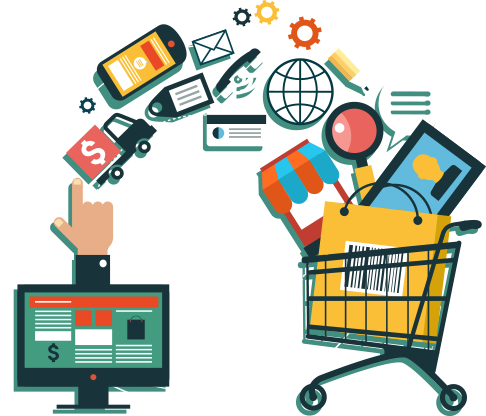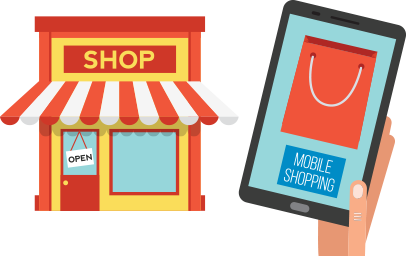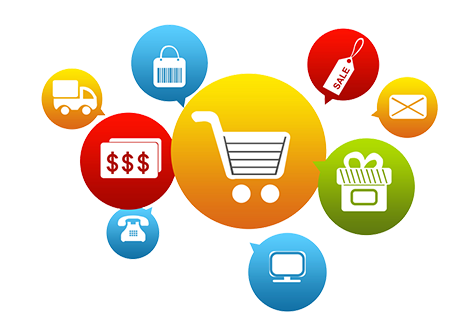Brick-and-mortar stores are facing the heat with plummeting mall traffic and a growing consumer preference for online shopping. According to a study by MasterCard, 7 out of 10 consumers use a PC, tablet, smartphone, or in-store technology while making a purchase. Anytime availability, worldwide reach, and excellent customer service fuel the engine of online retail. Here are some key trends that are emerging in the e-commerce realm.
M-commerce is on the move and traditional shopping has ‘appi-fied’ because it is quicker to pull out your phone and shop instead of logging on to a laptop or a PC. The year 2016 promises better experiences for avid mobile shoppers with modified shopping carts to cut down cumbersome checkout processes. The higher the number of taps and clicks it takes a user to make a purchase, the higher are the chances of the user ghosting your app.
Old payment terminals are also giving way to newer models such as EMV cards (Europay, MasterCard, and Visa) and mobile payments, which not only guarantee compliance and security but also enhance the overall customer experience.
A notable example would be the PayPal Here Chip Card Reader, which is compatible with both iOS and Android devices. It accepts both EMV and magnetic stripe cards, along with NFC payments such as Apple Pay, Android Pay, and Samsung Pay. Live chat is another trend which would be seen on our devices soon with retailers connecting with customers and offering personalized support based on their shopping habits.
‘Click and collect’ is getting bigger by the day and retailers are increasingly experimenting with this feature, which enables people to shop online and collect their items in-store. Notifications to alert you when an order is ready and getting associates to personally deliver your items to you outside the stores are some exciting initiatives that would be seen this year. Walmart Canada rolled out its ‘click and collect’ online grocery service earlier this year with orders that can be placed 21 days in advance with a pickup fee of $3, as reported by Financial Post.
Old payment terminals are also giving way to newer models such as EMV cards (Europay, MasterCard, and Visa) and mobile payments, which not only guarantee compliance and security but also enhance the overall customer experience.
A notable example would be the PayPal Here Chip Card Reader, which is compatible with both iOS and Android devices. It accepts both EMV and magnetic stripe cards, along with NFC payments such as Apple Pay, Android Pay, and Samsung Pay. Live chat is another trend which would be seen on our devices soon with retailers connecting with customers and offering personalized support based on their shopping habits.
‘Click and collect’ is getting bigger by the day and retailers are increasingly experimenting with this feature, which enables people to shop online and collect their items in-store. Notifications to alert you when an order is ready and getting associates to personally deliver your items to you outside the stores are some exciting initiatives that would be seen this year. Walmart Canada rolled out its ‘click and collect’ online grocery service earlier this year with orders that can be placed 21 days in advance with a pickup fee of $3, as reported by Financial Post.
Video marketing plays a major role in driving sales and marketing. A simple video can convert potential customers into loyal brand advocates by telling a heart-rending story, influencing emotions and behavior, and affecting tastes and preferences!
However it’s not just about engaging stories on YouTube. Popular brands have switched to Instagram and Vine for quirky updates to captivate their prospective customers. Leading cosmetics and skincare company The Body Shop combines product review videos and How-to videos of its bestselling products. The takeaway? The videos are linked to the brand’s channel on YouTube, which is a clever way to get more users and higher traffic!
Apart from that, online retailers are also using behind-the-scene production videos, 360-degree product rotations, and live streaming to give a realistic feel and help their shoppers connect with them instantly.
However it’s not just about engaging stories on YouTube. Popular brands have switched to Instagram and Vine for quirky updates to captivate their prospective customers. Leading cosmetics and skincare company The Body Shop combines product review videos and How-to videos of its bestselling products. The takeaway? The videos are linked to the brand’s channel on YouTube, which is a clever way to get more users and higher traffic!
Apart from that, online retailers are also using behind-the-scene production videos, 360-degree product rotations, and live streaming to give a realistic feel and help their shoppers connect with them instantly.
Whether you’re a store manager, marketing associate, or even a PR executive for your online retail brand, getting real-time updates on your customers’ preferences, shopping habits, time spent on a particular page, among other details, is undoubtedly going to help you make smarter decisions. 2016 sees a bright future with real-time analytics, which is going to be a game changer. Monitoring customer behavior enables you to identify what works and what doesn’t, repair issues on the fly, and talk to customers before they abandon your shopping cart, resulting in better conversions, better sales!
It might sound straight from a science fiction novel, but the days of getting milk and groceries ordered by our fridges, delivered to our doorsteps aren’t too far. The Internet of Things (IoT) innovation has reshaped the retail landscape because it guarantees a world of personalized and optimized shopping experiences across online, in-store, and mobile platforms. Here is how IoT is changing the Retail industry for customers and retailers:
- Reshaping customer experiences: Most customers today are pressed for time and expect seamless shopping experiences across every channel—be it a brick-and-mortar store, a website, mobile apps, or even talking to customer service. They expect personalized service, whether it’s shopping or scoring the best deals, and are sticklers for their favorite brands.
Amazon has launched its Dash physical instant purchase buttons in the UK, which means buying toilet rolls, washing powder, and other popular products across leading brands such as Listerine, Nescafe, Rimmel, Vanish, Huggies, and more can be done just with the click of a button. With the power of IoT, online retailers can rake in data from in-store IoT devices, enabling them to track their customers’ shopping habits and deliver personalized content and experiences in return. - Better supply chain management: Which product is trending, which one is not—and why? With the help of IoT-based solutions, retailers can get real-time data because they can monitor their inventory in better ways. The data can also inform retailers which items are running out of stock, which are overstocked, what are consumers bookmarking on their wish lists, and other potential variables.
Before the era of online retail, the motto was plain ‘try and buy’. But social networking and smartphones have added a whole new dimension to the retail experience and transformed the way consumers shop. With the help of online tools such as review sites, retailers can study the humongous data generated by popular social media sites such as Facebook, Twitter, and Instagram to provide personalized and timely offers to their customers.
Have you noticed the increase in ads as you scroll down your feeds? Old-fashioned banner ads are slowly giving way to a more realistic form of advertising such as sponsored posts. These posts look like normal updates from friends and acquaintances, but are sneaky yet effective ways of brand recall, targeting your usage habits. Advertisers take multiple factors into account apart from your age and gender, such as your hobbies, pages you follow, workplace, and check-ins. So the ads on your feed are those you actually want to see!
Have you noticed the increase in ads as you scroll down your feeds? Old-fashioned banner ads are slowly giving way to a more realistic form of advertising such as sponsored posts. These posts look like normal updates from friends and acquaintances, but are sneaky yet effective ways of brand recall, targeting your usage habits. Advertisers take multiple factors into account apart from your age and gender, such as your hobbies, pages you follow, workplace, and check-ins. So the ads on your feed are those you actually want to see!
Online retail channelizes the perfect synergy between payments, loyalty, marketing, and advertising; with 2016 continuing to be an innovator’s market, it’s indeed an exciting time for e-commerce with many power-packed trends to look forward to in the coming years!






